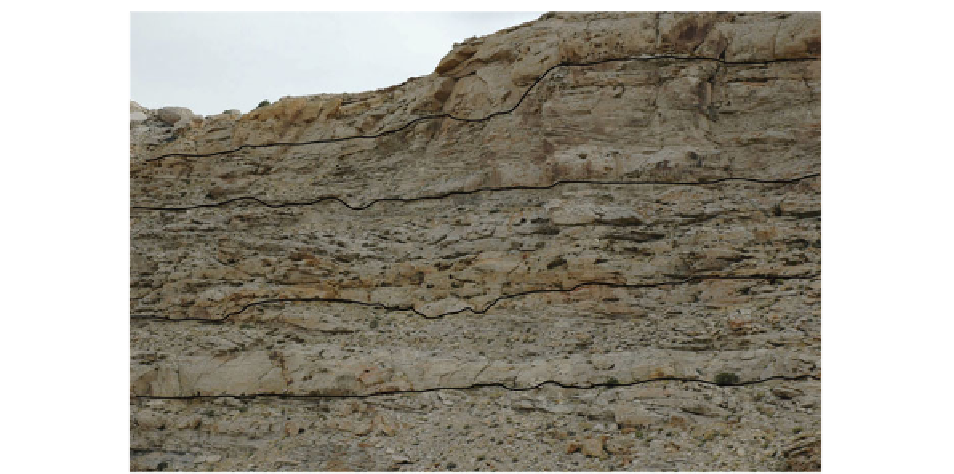Geology Reference
In-Depth Information
Fig. 17.27
A series of fi ve stacked and amalgamated fl uvial
to fl uvial-tidal facies successions (each 20-25 m thick). Each
succession has a sharply erosive base (
black lines
) overlain by
medium-grained, trough cross-stratifi ed sandstones, then
draped by one or more sets of inclined heterolithic strata. The
trough cross-stratifi ed intervals (apparently structureless in the
photo) are interpreted as fl uvial deposits, whereas the interven-
ing heterolithic intervals contain brackish traces (small
Teichichnus
) suggesting they represent transgressively depo-
sited lower coastal plain or inner estuary point bars. Trail
Member, Ericson Formation on Hwy 430, Rock Springs Uplift,
Wyoming
17.5.3 Causes of Tidal Amplifi cation
in the 77.5-75 My Interval
not necessarily cease at this time, but that foreland
basin subsidence was counteracted by early Laramide
movements and a change in slab subduction style
(Gurnis
1992
). Irrespective of the precise tectonic
causes, this new tectonic infl uence converted the earlier
back-tilted foredeep of the Western Interior Basin to a
fl at or slightly seaward-tilted, low-gradient landscape/
seascape that was hundreds of kilometers wide. The
embayed shorelines of this landscape in Utah-Colorado
(Aschoff and Steel
2010
) and across S Wyoming-N.
Colorado (Crabaugh
2001
; Gomez-Veroiza and Steel
2010
) repeatedly prograded for great distances, with
signifi cant tidal infl uence. The tectonic effects alone
do not 'cause' the tidal infl uence in the seaway, but
they had an important controlling infl uence on land-
scape slope and bathymetry as well as basin width and
coastline shape, that in turn was optimal for amplifying
tides during this interval in the epicontinental seaway.
Subsequently, major fl ooding with a tongue of wide-
spread Mancos Shale in the ammomite zone E.
jenneyi
(Fig.
17.3
) led to a new dominance of storm-wave gen-
erated shorelines (Rollins Sandstone in Colorado,
Trout Creek Sandstone in S Wyoming), with signifi -
cant tidal infl uence only in lowstand and transgressive
shoreline units.
The low average sediment accumulation rate (see
above) strongly indicates that deposition during this
particular stratigraphic interval was within a low
accommodation setting. The very extensive marine
transgressions of the Iles and Sego/Corcoran/Cozzette
shorelines and the even lengthier brackish/tidal incur-
sions back onto the coastal plains (Crabaugh
2001
;
Kirschbaum and Hettinger
2004
; Aschoff
2008
;
Gomez-Veroiza
2009
) also suggest that the coastal and
alluvial plains at this time had an extremely low gra-
dient. Liu and Nummedal (
2004
) and Liu and others
(
2005
) identifi ed the base of our low-accommodation
interval (base of their Megasequence 4) as a time of
tectonic change from relatively rapidly subsiding fore-
land basin conditions to isostatic fold-belt uplift and
erosion, following earlier suggestions by DeCelles and
Mitra (
1995
). However, the tectonic 'quiescence' of
the thrust activity (Liu et al.
2005
) at this boundary
appears to have been challenged by Horton et al. (
2004
)
who show evidence of thrust movements related to
Castlegate Sandstone at this time. Recent work by
Aschoff (
2008
) also suggests that thrust activity did

